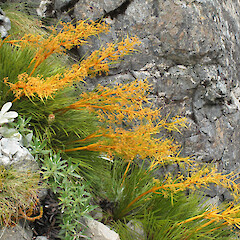Aciphylla montana var. montana
Synonyms
None
Family
Apiaceae
Flora category
Vascular – Native
Endemic taxon
Yes
Endemic genus
No
Endemic family
No
Structural class
Herbs - Dicotyledons other than Composites
Current conservation status
The conservation status of all known New Zealand vascular plant taxa at the rank of species and below were reassessed in 2017 using the New Zealand Threat Classification System (NZTCS) – more information about this can be found on the NZTCS website. This report includes a statistical summary and brief notes on changes since 2012 and replaces all previous NZTCS lists for vascular plants.
Please note, threat classifications are often suggested by authors when publications fall between NZTCS assessment periods – an interim threat classification status has not been assessed by the NZTCS panel.
- Conservation status of New Zealand indigenous vascular plants, 2017 . 2018. Peter J. de Lange, Jeremy R. Rolfe, John W. Barkla, Shannel P. Courtney, Paul D. Champion, Leon R. Perrie, Sarah M. Beadel, Kerry A. Ford, Ilse Breitwieser, Ines Schönberger, Rowan Hindmarsh-Walls, Peter B. Heenan and Kate Ladley. Department of Conservation. Source: NZTCS and licensed by DOC for reuse under the Creative Commons Attribution 4.0 International licence.
2017 | Not Threatened | Qualifiers: DP
Previous conservation statuses
2012 | Not Threatened
2009 | Not Threatened
2004 | Not Threatened
Distribution
Endemic. South Island, central southern Alps and east of the main divide from Mt Hutt to Mt Cardrona.
Habitat
Alpine (1400-2000 m a.s.l.) in tall tussock grassland, sometimes on or near rock outcrops or near the bases of stabilised scree slopes.
Detailed description
Rosettes 25 or more, each up to 250 mm diameter. Leaves coriaceous, yellow-green, up to 300 mm long, with 3(-4) leaflets, usually in one plane; sheath 80 x 5-15 mm, sheath joint obscure; stipules up to 70 x 1 mm, shorter than to almost as long as the petiole; petiole up to 90 x 3 mm, more or less convex above, margins rounded, pulvinus evident, up to 12 mm long, lamina more or less obtriagnular in outline, lowermost leaflet up to 130 x 2.5-4 mm, apex acute, spine 2 mm long, midrib obscure, marginrib 0.2 mm wide, veins not raised. Inflorescences narrow. Female inflorescence up to 600 mm long, with a stem 490 x 11 mm, yellow-orange; head 140 x 30 mm, more or less lanceolate in outline; compound umbels 20-25, arranged in 5-7 whorls, the terminal umbel smaller than the lower laterals; lower bracts 80 mm long, with a sheath up to 35 x 9 mm, stipules and 1-2 pairs fo leaflets; upper bracts smaller and simple with stipules. Lower compound umbels up to 35 mm long with peduncles up to 20 x 2 mm, occasionally sessile, primary bracteoles minute, simple umbels up to 6 with peduncles up to 12 x 0.7 mm, the innermost umbels sessile; secondary bracteoles simple, 7 x 1 mm; up to 15 flowers per umbel, pedicels up to 2.5 x 0.2 mm. Sepals up to 0.3 mm; petals up to 1 x 0.5 mm, not inflexed; staminodes up to 0.5 mm long. Male inflorescences up to 520 mm , stem 270 x 12 mm, yellow-orange; head 260 x 80 mm, lanceolate in outline; compound umbels up to 38, in 5-7 whorls, the terminal umbel smaller than the lower laterals; bracts similar to those of the female; lower compound umbels up to 80 mm long, usually as a whorl of 2 simple umbels on the peduncles, this up to 70 x 2 mm; up to 13 simple umbels with peduncles 12 x 0.4 mm, bearing up to 15 flowers per umbel, pedicels 2 x 0.1 mm. Sepals 0.3 mm; petals 1.2 x 0.8 mm, not inflexed; stamens up to 2 mm long. Mericarps 4.5 x 0.5 mm, dull pale brown, lateral ribs < 0.5 mm wide; style up to 1.2 mm.
Similar taxa
Aciphylla montana var. gracilis (W.R.B.Oliv.) J.W.Dawson is very similar (if not conspecific) it differs chiefly by its smaller stature, with plants forming rosettes of 5 or less (rather than 25 or more), leaves up to 230 rather than 300 mm long, and by the female inflorescences being up to 400 rather 600 mm tall. In A. montana var. montana there are usually 3 but sometimes 4 leaflet pairs, in var. gracilis there are usually 2 pairs of leaflets.
Flowering
December - March
Flower colours
Orange, Yellow
Fruiting
February to May
Life cycle
Winged schizocarps are dispersed primarily by wind (Thorsen et al., 2009).
Propagation technique
Difficult - requires specialist curation within an alpine house or in pots. Best in a climate prone to very cold winters and dry but cool summers. Requires free draining soils and full sun, in a moderately fertile substrate. Resents humidity and will not flower unless subject to cold treatment.
Etymology
aciphylla: From the Latin acicula ‘needle’ and the Greek phyllum ‘leaf’, meaning needle-leaf.
montana: From the Latin mons ‘mountain’, meaning growing on mountains
Attribution
Fact Sheet prepared for NZPCN by P.J. de Lange 28 May 2006: Description adapted from Dawson (1979).
References and further reading
Dawson, J. W. 1979: Aciphylla montana Armstrong, A. lecomtei sp. nov., and related species. New Zealand Journal of Botany 17: 339-351.
Thorsen, M. J.; Dickinson, K. J. M.; Seddon, P. J. 2009. Seed dispersal systems in the New Zealand flora. Perspectives in Plant Ecology, Evolution and Systematics 11: 285-309
NZPCN Fact Sheet citation
Please cite as: de Lange, P.J. (Year at time of access): Aciphylla montana var. montana Fact Sheet (content continuously updated). New Zealand Plant Conservation Network. https://www.nzpcn.org.nz/flora/species/aciphylla-montana-var-montana/ (Date website was queried)




